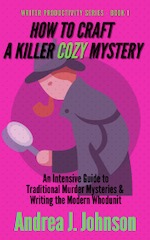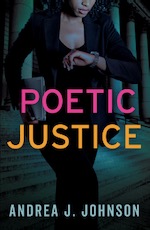by Andrea Johnson
I wish I had an inspirational story about how I chose to write cozy mysteries. But really, mysteries chose me.
I originally started writing romance then quickly got this innovative idea about a series that was part cozy, part legal thriller where the trial stenographer rather than the attorneys would track down the killer and solve the case.
Unfortunately, I had absolutely no idea how to write a mystery and the genre didn’t seem like one where I could bluff my way through or solve on my own.
Not that penning any story is easy, but with romance, I knew that I had to at least have a happy ending.
So I decided to go to grad school to learn more about writing in general and mysteries in particular.
I Decided to Go to Grad School to Learn More About Writing Cozy Mysteries
While this may seem like an extreme choice for a simple problem, you must understand that this decision fit my personality.
I started writing very late into my adulthood and didn’t know anyone who was a writer or anyone who had ever succeeded at doing something creative, so going to graduate school made sense.
The act gave me a tribe—a group of people I could count on for answers and resources that would put me on the path to publishing success.
I don’t think taking such a drastic step is necessary for everyone, but I’d always wanted a compelling reason to pursue an advanced degree and figured the effort would (and did!) create connections that would open doors.
I Honestly Believe Writing Cozy Mysteries is Difficult
How to Craft a Killer Cozy Mystery came about for two reasons.
Primarily, it was a way for me to keep writing during the pandemic. I found that I just couldn’t get myself to be creative during that period of isolation and took solace in the act of writing instructively.
I was teaching online at the time, and I am sure my subconscious connected the act of “how to” writing with my only social time—educating community college students on the elements of story.
The other reason I wrote this book is that I honestly believe writing cozies is difficult, and there are very few guides out there. People tend to consider the genre mindless fluff—you know, all talking cats and quilts with no real substance—but I wholeheartedly disagree.
It is extremely difficult to create a gruesome crime in an idyllic community all while making people laugh as you stump them with a twisty puzzle that ends with justice being served.
The Three Missteps I Made While Learning to Write Cozy Mysteries
As I mentioned, I didn’t know much about cozies when I started writing them. I hadn’t even read any books in the genre, which in hindsight was my first mistake.
If you want to succeed at this business, you have to study what is out there because every genre has reader expectations, which we will talk about in a moment.
The second misstep was that I thought I could get by with minimal dialogue. Since I often write in first person, drafts of my early work consist of my sleuth engaging in a ton of internal musing. But anyone who has ever seen an episode of Law & Order knows that solving a crime is all about the question and answer.
The sleuth must hit the street and ask the hard questions, preferably at a time and in a place that’s both inconvenient and uncomfortable for her and her suspect to create additional scene conflict and tension.
The third pitfall of getting started was thinking that I could write a mystery without an outline. And yes, I know all of the pantsers out there are clutching their pearls and gnashing their teeth at my diss against their way of life. However, I’ll take the heat on this one because I firmly believe that with mysteries you at least need to have a few things set before you get started:
- Who is your sleuth? Why does she feel compelled to solve the crime? And what personal wound initially gets in the way of her seeing the solution?
- Who is your victim? What is his or her role in the community? What consequence does their death have?
- Who is your killer? What is his or her relationship to the sleuth and victim? What personal reason has compelled them to kill, and why now?
Why You Must Pay Attention to Reader Expectations When Writing Cozy Mysteries
Folks who have been reading closely may have already figured out the first two [key reader expectations for cozy mysteries].
In cozies, we usually have an amateur sleuth as the protagonist and that person is typically female. Of course, we can always point to notable exceptions such as Jeff Abbott’s Jordan Poteet series. But in general, since the genre is marketed toward middle-aged females, the protagonists for these books typically reflect that base.
Another main cozy characteristic is that the action takes place in a communal setting so that the suspect list remains small and the sleuth has access to everyone for questioning.
This often means cozies take place in small towns, but the truth is that any microcosm within a larger part of society will do. For example, the glee club at UCLA or the congregation of a New York City church. Readers simply want a group setting that feels familiar and well…cozy.
In other words, knowing the reader expectations for your genre will help your book find the proper place on the shelf and ensure audiences are satisfied. This leads to positive reviews and solid word of mouth.
What’s the Difference Between a Premise and a Hook?
I talk about the difference between a premise and a hook because I think it is important to note that a premise is so much more than deciding whether your book is going to be a pet cozy or catering cozy.
A premise is the story’s overarching concept or idea and should encompass the story’s theme and main conflict in a couple of catchy lines.
I think that word “catchy” causes people to conflate “premise” with “hook.”
In my mind, the hook is really the writer’s ability to create an opening line and paragraph that captures that reader’s imagination and interest. You do this by hinting at danger ahead and reeling them in with compelling questions about the fate of the world being introduced.
With these more concrete definitions in mind, the difference and importance of each word becomes obvious—one gets the audience to buy the book, the other keeps the audience turning pages.
Why Is the Four-Act Structure Important for Cozy Mysteries?
The four-act structure is important for mysteries because of the detection cycle every sleuth must endure before successfully solving the crime.
Cozies in particular require this format since they usually wait until the end of the first act for the sleuth to even agree to undertake the case.
Why? Well, the narrative must first justify why an amateur rather than the police endeavor to solve something as tricky as a murder. This alone implies the first act is setup while the other three contain the detection, complication, and resolution.
So with that delineation in mind, the second act follows the sleuth as she identifies her suspects and questions them. But by second act’s end, she typically hits the major setback of a second body or a missing witness.
The third act involves untangling all the confusion caused by the major setback only to discover that the sleuth has been looking at the murder or murderer wrong all along.
Then the fourth act focuses on unmasking/confronting the killer, laying out the truth for the audience, and restoring justice so the sleuth can return to her ordinary world.
What’s the Difference Between Fiction and Nonfiction Writing?
Gosh, I’ve never really thought about the difference between fiction and nonfiction writing. I am sure there are several (specifically in the way one queries for each—see links), but I don’t think I am able to discuss either objectively.
You see, in the handful of years I’ve been writing, my main way of gaining experience has been to write opinion pieces for online magazines. Therefore, the act of explaining something and the act of storytelling has become intertwined for me.
I will say that nonfiction writing involves loads of research upfront. You must understand your subject before you can write about it. Once you do, the task is to pull out the most pertinent pieces of that research to support your thesis.
On the other hand, fiction is more of a feeling that you run with until you come up against a choice you can’t see past or a conflict that doesn’t yield any tension. That’s when you go back into your character sketch, work on GMC (goal/motivation/conflict), and do additional research into the structure for your genre.
Basically, I’d say the key in both instances is to first gain clarity about what you want to say or convey—this will make the writing process run smoother.
Self-Published or Traditionally Published: Which One for You?
I think the old argument used to be, “I gotta be traditionally published because I want to get my novel in the bookstore and be eligible for the major awards in my genre.” But that argument becomes less and less true with each passing day.
We all know plenty of writers who are traditionally published but who aren’t in bookstores and haven’t caught wind of any awards. We can also name several people like Kennedy Ryan and B.B. Easton who are not only self-published and in bookstores but have won major awards and have Hollywood development deals for their work.
These days the door swings both ways. Money can be made on both sides. Kindle Direct Publishing, IngramSpark, Draft2Digital, and social media have leveled the playing field and made is possible for anyone to become a booktrepreneur.
The question for you, my fellow artist, is if you want the control of indie publishing and the excruciatingly hard work that comes with self-marketing or would you rather lose significant control and money to gain the polished touch and professional push that comes with a traditional publishing house?
My Best Book Marketing Tool: Teaching
I am a nurturer by nature, so teaching classes has been the best marketing tool for my books.
I have gone out of my way to lead workshops both in person and online. That’s where the MFA has really come in handy because the degree speaks to a certain level of expertise.
In fact, I have a FREE online seminar coming up that anyone can sign up for and take at their leisure via Savvy Authors: Three Steps to the Perfect Author Tagline!
Advice for a Young Author Interested in Writing Cozy Mysteries: Find a Heroine That You Love
My main advice for writing a cozy mystery is find a heroine that you love.
This is more important than you think.
Most readers expect authors to start their cozies with a series in mind. That means you’re going to be with that main character for a long time. And if you’re smart, you’ll set her up so that she has room to grow as the books evolve.
I always think about the Southern Vampire Mysteries by Charlaine Harris in this regard. We essentially see Sookie Stackhouse change from a naïve young girl living with her grandmother to a fierce woman determined to live life on her own terms.
Now, you don’t need to follow that exact model, but growth of any kind will keep you from getting bored with the character, infuse fresh blood into your series, and provide your reader’s reason to return to your novels again and again.
* * *
 Andrea J. Johnson is the author of the Victoria Justice Mysteries, a series of cozy courtroom whodunits (think Murder, She Wrote meets The Pelican Brief). She is also a freelance entertainment writer for the women’s lifestyle websites Popsugar and The List Daily.
Andrea J. Johnson is the author of the Victoria Justice Mysteries, a series of cozy courtroom whodunits (think Murder, She Wrote meets The Pelican Brief). She is also a freelance entertainment writer for the women’s lifestyle websites Popsugar and The List Daily.
In addition, she’s written several articles on the craft of writing for websites such as LitReactor, CrimeReads, Funds for Writers, and DIY MFA. Her education includes a copyediting certification from UC San Diego, a B.A. in English from Swarthmore College, and an M.F.A. in Writing Popular Fiction from Seton Hill University.
Her latest book is the author instruction manual How to Craft a Killer Cozy Mystery. For more information about Andrea and her work, please see her website and connect with her on Twitter, Bookbub, Goodreads, Instagram, and Pinterest.
(Featured image by cottonbro from Pexels.)
 How to Craft a Killer Cozy: Crafting a killer cozy can be perilous.
How to Craft a Killer Cozy: Crafting a killer cozy can be perilous.
Fans of the genre expect authors to avoid explicit gore and violence while at the same time creating a mind-boggling murder mystery with pulse-pounding tension and a twisty plot. But how is a writer supposed to satisfy such disparate demands?
How to Craft a Killer Cozy Mystery tackles this exact problem by providing an actionable roadmap for starting (and completing!) a manuscript that will leave readers dying for more. Packed with charts and questionnaires designed to streamline the writing process, this comprehensive step-by-step guide will help you create compelling characters, vivid settings, and clever storylines.
Whether you’re a new writer or just new to the genre, you will walk away from this book with a checklist for everything you’ll need to complete the novel of your dreams.
Available at Amazon, Barnes & Noble, and other bookstores.
 Poetic Justice: Twenty-five-year-old Victoria Justice has never really gotten over a near drowning at the hands of a high school bully but has attempted to build her confidence and career as a court stenographer under the mentorship of The Honorable Frederica Scott Wannamaker, the county’s first African American Superior Court judge.
Poetic Justice: Twenty-five-year-old Victoria Justice has never really gotten over a near drowning at the hands of a high school bully but has attempted to build her confidence and career as a court stenographer under the mentorship of The Honorable Frederica Scott Wannamaker, the county’s first African American Superior Court judge.
But when Victoria’s childhood nemesis appears on the court docket, our heroine’s carefully crafted world implodes―evidence goes missing, a potential mistrial abounds, and the judge winds up drowned in the courthouse bathroom.
Victoria quickly realizes her trial transcript unlocks everyone’s secrets…including the murderer’s. But can Victoria suppress her fears long enough to crack the code, reclaim her voice, and avoid the crosshairs of the killer?
Available at Amazon, Barnes & Noble, and other bookstores.

